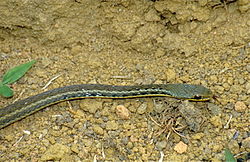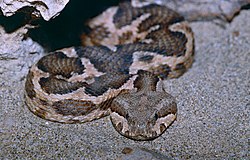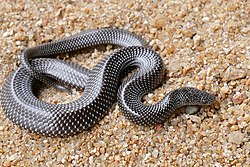The Australian zoologist (1973) (20162909300)
Title: The Australian zoologist
Identifier: australianzoolog18191roya (find matches)
Year: 1914 (1910s)
Authors: Royal Zoological Society of New South Wales; Royal Zoological Society of New South Wales. Proceedings
Subjects: Zoology; Zoology; Zoology
Publisher: (Sydney, Royal Zoological Society of New South Wales)
Contributing Library: Smithsonian Libraries
Digitizing Sponsor: Biodiversity Heritage Library
View Book Page: Book Viewer
About This Book: Catalog Entry
View All Images: All Images From Book
Click here to view book online to see this illustration in context in a browseable online version of this book.
Text Appearing Before Image:
G. F. GOW DESCRIPTION OF HOLOTYPE A large boid snake with a strongly prehensile tail. Scales without apical pits and without granular gular scales bordering the mental groove. Rostral visible from above, slightly broader than long, with a pair of deep slit-like sensory pits. Supralabials 15, the seventh and eighth on the left side and the seventh, eighth and ninth on the right entering the eye. First three supralabials with deep sensory pits; pit of first supralabial a long diagonal slit broadening dor sally and contacting ventral edge of the nasal. The slit of the second supralabial almost contacts ventral edge of nasal; third supralabial slit is distinct but shorter and broader than first two. Fourth supralabial without a distinct slit but an obscure elongate mark is present. Infralabials 24, six of the more posterior infralabials with deep rectangular pits. The row of infralabial pits begins beneath the eye and is sunk in a longitudinal groove. The row is preceded by an infralabial with a shallower pit. One pair of prefrontals is present, each almost twice as long as broad. Internasals preceded by a pair of small scutes. The posterior prefrontal area, extending to the anterior frontals and supraoculars, consists of 22 subequal scales.
Text Appearing After Image:
Fig. 1. Python oenpelliensis n. sp., holotype, in life. 134 Aust. Zool. 19(2), 1977
Note About Images
Relevante Bilder
Relevante Artikel
Liste der SchlangenartenIn dieser Liste sind alle 3971 momentan bekannten lebenden Arten der Unterordnung der Schlangen (Serpentes) aufgeführt. Grundlage für die Liste ist die Online-Datenbank Reptile Database, die Rote Liste der bedrohten Arten (IUCN) und die Artenliste am Ende des Buches Schlangen – Die interessantesten Arten der Welt von Chris Mattison. Die Unterteilungen in Familien und Unterfamilien sind oft nicht eindeutig, zum Beispiel wird die Unterfamilie der Natricinae im Buch als eigenständige Familie Natricidae angeführt, in dieser Tabelle sind sie aber wie bei der Reptile Database unter den Nattern (Colubridae) gelistet. Auch bei der Gattungszugehörigkeit der einzelnen Schlangenarten ist sich die Wissenschaft oft nicht einig, weswegen auch diese geändert werden. Der Spalte „Weiteres“ kann man entnehmen, ob von einer Art nicht viel bekannt ist, ob sie ausgestorben ist oder ob sie auch noch einen anderen wissenschaftlichen Namen hat(te) (Synonym). .. weiterlesen
OenpellipythonDer Oenpellipython, auch Oenpelli-Python, ist eine Art aus der Familie der Pythons (Pythonidae). .. weiterlesen










































